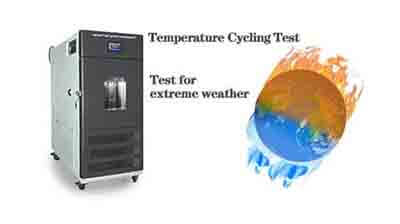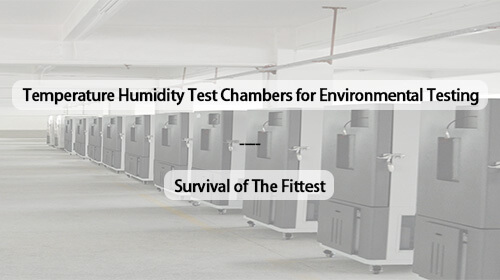Temperature humidity test chambers replicate both the humidity and temperature of the environment. Humidity readings at intense temperatures signal to testers how they react to cold, hot, humid, and arid conditions in various mixes. Controlling humidity is hard without maintaining temperatures. Both temperature and humidity are directly proportional. Consequently, both functionalities are essential to examine. In the present technology and production world, it is inadequate to design, make, and distribute goods. So, producers have to be sure their products will defy all of the ecological pressures and stresses.
“Main Focus of Temperature humidity test is to put products in an intense environmental stress to measure how they cope up failures.”
Fortunately, there are simple kinds of temperature humidity test chambers accessible to all manufacturers and designers that guarantee optimal product performance. Besides, environmental changes in things such as humidity and temperature strongly impact manufactured product functionality. It may be outside states where weather variables change with varying seasons or artificial surroundings where space conditions affect products. Therefore, professional humidity and temperature testing chambers account for these interactions, along with the testing procedure. We do temperature and humidity tests to enhance the long-term durability and service life of goods. The manufacturing industry uses humidity and temperature testing for the environment. This Procedure functions to establish product visibility as well as guarantee regulatory compliance.
A Quick Overview of Temperature Humidity Test Chambers
What are Temperature Humidity Test Chambers?
Temperature and humidity testing are an umbrella term. It is an engineering and production generalization to get a host of environmentally conscious experiments like high / low-temperature testing, corrosion testing, or temperature cycling testing. Testing technicians set subject substances in a controlled temperature of humidity test chambers and then adjust humidity, temperature, and additional forces. These low and high parameter changes may cause products to fail automatically, fog or overeat, let water ingress in addition to degrading structural substances. The temperature humidity test chamber is among those industrial tools utilized by a significant number of different sectors. The most crucial intent is to observe the gap and the ramifications of the humidity and the greater temperature about the commodities.
How are Temperature and Humidity Test Chambers Works?
Steam is among the fundamental elements which we must generate and keep within the room. Thus, this extra moisture is responsible for exposing the substances and the goods for a particular length of time. Here is the test that demonstrates the impact of additional water on the material. Indeed, the process of degeneration starts, and the substance that’s becoming affected first will be the critical findings from this evaluation.
How is the Steam Made?
The steam within the temperature humidity test chambers made through different kinds of artificial procedures. One of the most frequent processes that they utilize for the use of steam production are those of
- Steam generator
- Atomizer
- Water tub
Environmental Chambers: Temperature & Humidity Chambers
Temperature Chambers: Temperature is Elemental
The chamber maintains the temperature inside the rooms at a high degree. The evaluation’s primary motive is to find the changes and the process of degeneration at a product when we expose it to a high temperature. Hence, the manufacturer constructs these temperature humidity test chambers, mainly to preserve a high temperature inside it for a substantial period. Therefore, Building the temperature humidity test chamber with unique excellent glass wool panels is the reason.
Humidity Chambers: Determining the Impact of Humidity on Products
Temperature humidity test chambers are the perfect testing chambers integrated with the latest technology qualities to make different relative humidity and temperature within the room. These chambers guarantee less heat reduction ratio. Since the company designed the test chambers with higher insulation quality using sterile glass wool. Compartments include cooling compressors in addition to heaters to keep a suitable quantity of humidity and temperature. The humidity chambers are all used to evaluate the impact of different climate conditions on the physical, mechanical, and chemical properties of the merchandise during the actual time working on the item.
Weaknesses that can be Found by Temperature Humidity Test Chambers
Temperature humidity test chambers are the production industry’s top way to identify and rectify weakness in all sorts of goods. Testing exposes flaws through low and high temperatures, high and shallow temperatures, thermal cycling, and thermal shock. These complex tests expose merchandise vulnerability and forecast product survivability. All humidity and temperature analyzed products are life-tested, qualified, and analyzed. The outcome is a recognized certificate that safeguards the customer and improvements the maker as a business pioneer. Listed below are a couple of flaws typically identified through humidity and temperature testing:
- Analyze Epoxy Coated Products
Temperature and humidity testing chambers place epoxy-coated goods under extreme stress. Any flaws via contraction, expansion, humidity ingress and surface rust or abrasion are all exposed.
- Sealed Units Test through Fogging
We can find the weakness of windows and windshield with this technique. Any merchandise flaws quickly show stress when exposed to cold and hot cycles of moist and dry. Moisture fogging between layers is a sure indication of product failure.
Products subjected to moist surroundings are great candidates for testing. Water leakage or ingress flaws become quickly apparent after analyzing. Those failures may emerge immediately under testing, or else they can have a lengthy test period.
- Finding Mechanical failures
Changes in cold and heat cycles may take a toll on several products, frequently ending in small or catastrophic mechanical failure. Testing is front-line insurance from goods failing in the area and resulting in harm or injury.
Applications of Temperature Humidity Test Chambers in Industry
These temperature and humidity test chambers are usable in various kinds of businesses.
Pharmaceutical Industries
To examine the effect of an exceptionally humid environment on medications and drugs.
Rubber Industries
To ascertain the fracture initiation or melting of rubbers from the cold and hot atmosphere.
Plastic Industries
To assess the influence on plastic goods’ physical and mechanical properties in a humid environment and high temperatures. This assists in the competitive development and advancement of those businesses. The following are a few of the specific businesses employing humidity and temperature testing regularly:
- Aerospace
- Automotive
- Defense
- Energy
- Telecommunications
The listing of goods acceptable for humidity and temperature testing is very long. It truly depends upon the product’s planned working atmosphere. The kind of testing also is dependent upon the industry using it. Each business has its distinctive products in addition to individual specifications and testing parameters. The listing is as diverse as the business and the planned program. Here are only a few goods and items Acceptable for humidity and temperature testing:
- Electrical equipment
- Engine assembly components
- Batteries and solar panels
- Medical diagnostic products
- Pharmaceutical drums
- Military munitions and weapons testing
- Adhesives and caulking products
- Glazing merchandises
Essential Use of Temperature Humidity Test Chambers in the Pharmaceutical Industry
- Temperature-humidity Graphs
Temperature-humidity graphs provide a fast summary of all attainable humidity and temperature values in addition to weather conditions. The operation ranges of the various temperature humidity test chambers change considerably.
- Vertical or horizontal airflow
In the case of flat airflow, air wracking evenly over every shelf, no matter the shelf’s place in the climate room. Optimal humidity and temperature supply are attainable while the room is loaded. It is particularly true in the event of a double-sided, flat airflow.
Water that we provide into these temperature humidity test chambers also must be of excellent quality. Link to a water source and drainage center on-site is one alternative. Utilizing large-volume water canisters to provide freshwater and accumulate wastewater directly in the humidity test chambers is just another.
Humidity test chambers operate for more than 8,000 hours Each Year in continuous operation. Robust designs, durable materials, and elements designed to provide maximum reliability will be the foundations, promising these demanding running occasions are preservable over several decades.
Best Temperature Humidity Test Chambers – DGBell Test Chambers
All the Environmental Associated test chambers are all equipped with distinct data-acquisition equipment for humidity and temperature tracking. Our Temperature and Humidity test Chambers could be easily equipped with technical information acquisition to record chamber conditions along with the test article at multiple data points. A number of our temperature and humidity chambers are equipped with high performance, maximum-size compressors to generate special ramp rates equivalent to or over 15°C per second. Bell’s Temperature and Humidity Test Chamber can simulate a broad assortment of humidity and temperature environment requirements for analyzing various components and products. You can employ it for actual operation cycling tests and rapid stress tests.
Features of DGBell Temperature Humidity Test Chambers
- The substance of the building
We create our humidity and temperature chambers out of completely corrosion-resistant substances. Also, the bell company makes the inner chamber out of high-grade stainless steel. However, the outside consists of a rust-resistant powder coated GI sheet. The gap between both of these walls is full of thick coating off high-density PUF insulation.
Some humidity chambers easily fit with internal glass doors for monitoring. Substantial size beams consist of double doors. Instead, doors are fit able with glass and defogger (Heating strings placed round the doorway to reduce Condensation) to see inside during freezing state.
We use only environmentally safe Silicone gaskets that are high-temperature resistance, aging resistant. Additionally, it has an attribute of excellent sealing capacity. Low-temperature room chambers have the feature of dual sealing.
This control features a color touch display, graphical display, and data logging. Users may place the temperature and humidity variety with profiling. Besides, we supply ethernet connectivity if needed.
Proper airflow needs any humidity test room. Bell temperature humidity test chambers utilize heavy-duty engine driven blowers or stainless-steel axial flow fans to get quick and uniform air supply throughout the chamber.
For efficient cooling, Bell temperature humidity test chambers utilize hermetically sealed CFC free compressors of reputed manufacturers in the marketplace, including EMERSON.
To be able to create humidity within the room, we equip our evaluation chambers using stainless steel water heaters tanks equipped with immersion heaters for vaporization. Bell temperature humidity test chambers also match the low water cut-off apparatus.
Programmable temperature and Humidity Test Chambers
The developer contains a fever alarm as only one interface of Grande’s Three-tiered over-temperature defense system. Bell temperature humidity test chambers also included a thermal fuse and user-set independent limitation. Additionally, a specimen electricity terminal enables the user to operate powered equipment indoors or together with the room securely.
Humidity Test
Bell temperature humidity test chambers will help you to monitor your products through constant temperature humidity tests. For example, they maintain the IEC 68 environmental test standard for all types of electronic and electrical products, MIL-STD-810D standard for high and low temperature test purposes.
Temperature Tests
- Pre and Post Retrieval
- Thermal Shock
- Accelerated Weathering
- Accelerated Aging
Pros
- Double-walled finish
- External light steel powder-coated in addition to yank insulation service
- Stainless Steel perforated adjustable shelves
- Test Space 400x500x400
- External Dimension 650x1650x1270 mm
- Cooling Method Air-cooling
- Temperature Range 0~150℃
- Humidity Range 20% RH-98%RH
- Temperature Fluctuation ±0.5℃
- Humidity Fluctuation ±2%RH
- Heating Rate Approximately 3℃/min
- Provides functioning on 220 v ac provide Chamber
- Featuring highly polished stainless steel sheet
- Quality engine mill for forced airflow
- Precision air ducting service for permitting positive atmosphere flow system meant to maintain constant temperatures in the room
- For preventing thermal reduction, the system includes puff insulation supplied between outer and inner walls
- Gear fitted using hermetically sealed compressors with CFC free refrigerants two doors assistance together with an internal full-length translucent door
- Sturdy hinge support along with magnetic gasket supplied for dual walled principal doorway Automated temperature controller provided through electronic temperature control and index System using PID controller.
Things to Consider Before Buying a Temperature Humidity Test Chamber
How can you buy the best temperature humidity test chambers? What standards do you have to maintain in the choice of an ideal chamber provider? To be able to make the best choice to buy a suitable temperature and humidity room, many elements will need to be considered. The following guide will assist you to make. We have analyzed different products and suggest you consider these 6 parameters when you want to purchase a test machine-
- Temperature Range
- Humidity Range
- Temperature Change Rate
- Internal Dimension
- Product in Chamber
- Cooling method
Wrapping Up
The tests which are done through these temperature humidity test chambers evaluations the elemental quality as well as the durability of the merchandise. These test chambers are made from rather quality glass wool panels which help lock the warmth and the moisture inside. They also come with numerous methods for creating steam. The use of those test chambers is very popular across different areas of the planet. Many businesses are using those test chambers for greater product variants and much more competitive marketplace dynamics.















